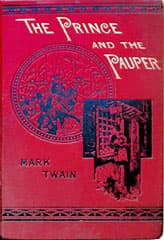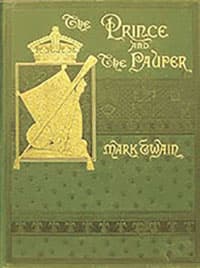The Prince and the Pauper
CRITIQUE | THE TEXT
 First Canadian edition
First Canadian editionSubtitle
A Tale For Young People of All Ages
First publication
1881
Literature form
Novel
Genres
Literary, historical fiction, adventure, children's
Writing language
English
Author's country
United States
Length
Approx. 60,500 words
The bite in an ageless tale
It's easy to overlook Mark Twain's bite in The Prince and the Pauper. The social criticism is not as sharp as in some of his later novels, like The Adventures of Huckleberry Finn or A Connecticut Yankee in King Arthur's Court. There's little of the outright sarcasm or open attack on institutions and other writers found in his later commentaries.
But the harshness is there, though ultimately sugar-coated, in The Prince and the Pauper. It's easy to miss if you are reading the story as a tale of mixed-up twins (not really twins but strangely identical lads) who are both miserable in their own ways after being thrown into opposite social classes, until the happy ending sorts it all out. The book is often presented as a kind of children's fairy tale.
I'm not certain what exactly gives it the air of being a kids' book. The subtitle stating it's for "young people of all ages" is ambiguous. The writing is straightforward and language simple, but that's true of many a great adult novel—and there are all those footnotes and historical details that would tend to discourage kids. The humour, if you can find it, is more subtle than in other works of the man often called a humorist.
What makes it a children's book to some readers seems to be that it has youngsters in the leads. As in Huckleberry Finn, Twain uses the adventures of a young boy in desperate straits, struggling through the world, meeting with various shades of humanity good and bad, to show us all sides of life at a certain place and time.
It's a classic strategy for novelists, witness Dickens's earlier Oliver Twist, Stevenson's contemporaneous Kidnapped, and Kipling's later Kim. And, as in those works, order is restored by the resolution and the youths receive their just reward—as do their antagonists. A fairy tale ending, as they say.
But along the way the picture drawn of English life, justice and class system is horrendous.
Twain has said he wrote The Prince and the Proper to show what life really was like in England, to counter the notion spread by some American writers that Britain was more civilized than America. He had originally placed the story in his own Victorian times but found it worked better in the mid-1500s featuring the short-lived child monarch Edward VI, the "prince" of the story.
It was a brutal time, when the masses lived and died in deadly poverty and the nobility enjoyed lives of relative ease and luxury, while organizing their rapacious wars ion their rivals and executing their own people for a long list of most minor offenses.
The quality of mercy
In a way, you could say Twain was writing an anti-fairy tale, satirizing those ideas people had received from folk stories of noble rulers and upwardly mobile subjects. Tom Canty, the "pauper" of the story, is a parody of a subject, dreaming of becoming royalty and aspiring to someday come into the good life—and against all odds finding his dreams coming true.
Both he and the prince, with whom he trades places, are appalled at the reality they each discover, but somehow remain innocent and idealistic. When they have power, they try to reform the punitive system, living up to the novel's epigraph, the call for mercy from Shakespeare's The Merchant of Venice (though Shakespeare actually lived after the time of this fiction).
But Twain also knew he was writing entertainment. However dark the journeys of the two boys, especially of the cast-down prince, and however many times their efforts are thwarted, the delivery from the depths, when it finally comes, must have readers standing up and cheering. It's such a relief.
And that's all down to Twain's skill. He really knew how to plot suspensefully and write a dramatically satisfying climax, when he wanted to.
The Prince and the Pauper is one of Twain's most traditionally written works, with his still developing humanism and social critique playing second fiddle to the adventure story. But it's still an exciting tale for kids both young and old.
— Eric
CRITIQUE | THE TEXT



